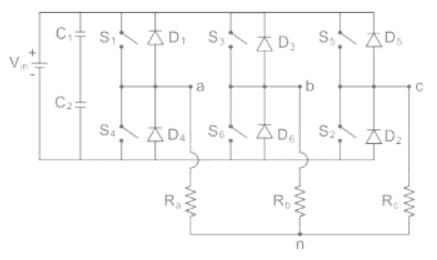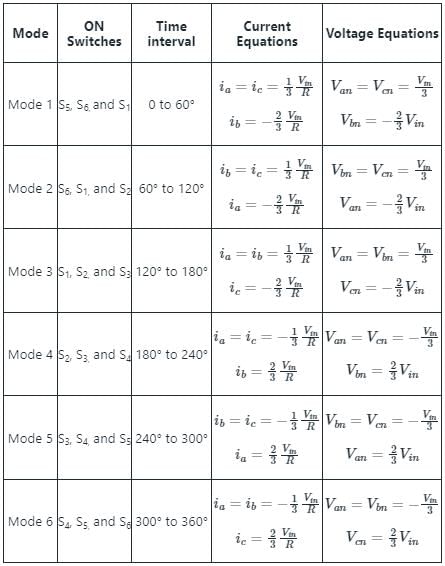Electrical Engineering (EE) Exam > Electrical Engineering (EE) Questions > In a 3-phase inverter with 180° conductio...
Start Learning for Free
In a 3-phase inverter with 180° conduction mode the number of switches that is on at any instant of time is
- a)1
- b)2
- c)3
- d)4
Correct answer is option 'C'. Can you explain this answer?
Verified Answer
In a 3-phase inverter with 180° conduction mode the number of swit...
180-degree conduction with star connected resistive load:

The configuration of the three-phase inverter with star connected resistive load as shown in the figure. The following convention is followed.
- A current leaving a node point a, b or c and entering the neutral point n is assumed to be positive.
- All the three resistances are equal, Ra = Rb = Rc = R
In this mode of operation, each switch conducts for 180°. Hence at any instant of time three switches remain on. There are six possible modes of operation in a cycle and each mode is of 60° duration and the explanation of each mode is as follows:


Most Upvoted Answer
In a 3-phase inverter with 180° conduction mode the number of swit...
Degree conduction, each phase conducts for 180 degrees, or half of the 360-degree electrical cycle. This means that each phase is active for a duration of 180 degrees, while the other two phases are inactive.
During the active phase, the input DC voltage is converted into an AC output voltage by switching the transistors or switches in the inverter circuit. The switches are turned on and off in a specific sequence to create a sinusoidal output waveform.
The inactive phases are not conducting and do not contribute to the output voltage. However, they play an important role in creating a balanced output waveform. The inactive phases provide a path for the current to flow back to the DC source, completing the circuit.
By controlling the switching sequence of the transistors, the inverter can generate a 3-phase AC output with a fixed amplitude and frequency. The 180-degree conduction allows for a balanced output waveform, which is important for the operation of 3-phase loads such as motors.
Overall, a 3-phase inverter with 180-degree conduction provides a controlled and balanced AC output voltage from a DC input source.
During the active phase, the input DC voltage is converted into an AC output voltage by switching the transistors or switches in the inverter circuit. The switches are turned on and off in a specific sequence to create a sinusoidal output waveform.
The inactive phases are not conducting and do not contribute to the output voltage. However, they play an important role in creating a balanced output waveform. The inactive phases provide a path for the current to flow back to the DC source, completing the circuit.
By controlling the switching sequence of the transistors, the inverter can generate a 3-phase AC output with a fixed amplitude and frequency. The 180-degree conduction allows for a balanced output waveform, which is important for the operation of 3-phase loads such as motors.
Overall, a 3-phase inverter with 180-degree conduction provides a controlled and balanced AC output voltage from a DC input source.

|
Explore Courses for Electrical Engineering (EE) exam
|

|
Question Description
In a 3-phase inverter with 180° conduction mode the number of switches that is on at any instant of time isa)1b)2c)3d)4Correct answer is option 'C'. Can you explain this answer? for Electrical Engineering (EE) 2025 is part of Electrical Engineering (EE) preparation. The Question and answers have been prepared according to the Electrical Engineering (EE) exam syllabus. Information about In a 3-phase inverter with 180° conduction mode the number of switches that is on at any instant of time isa)1b)2c)3d)4Correct answer is option 'C'. Can you explain this answer? covers all topics & solutions for Electrical Engineering (EE) 2025 Exam. Find important definitions, questions, meanings, examples, exercises and tests below for In a 3-phase inverter with 180° conduction mode the number of switches that is on at any instant of time isa)1b)2c)3d)4Correct answer is option 'C'. Can you explain this answer?.
In a 3-phase inverter with 180° conduction mode the number of switches that is on at any instant of time isa)1b)2c)3d)4Correct answer is option 'C'. Can you explain this answer? for Electrical Engineering (EE) 2025 is part of Electrical Engineering (EE) preparation. The Question and answers have been prepared according to the Electrical Engineering (EE) exam syllabus. Information about In a 3-phase inverter with 180° conduction mode the number of switches that is on at any instant of time isa)1b)2c)3d)4Correct answer is option 'C'. Can you explain this answer? covers all topics & solutions for Electrical Engineering (EE) 2025 Exam. Find important definitions, questions, meanings, examples, exercises and tests below for In a 3-phase inverter with 180° conduction mode the number of switches that is on at any instant of time isa)1b)2c)3d)4Correct answer is option 'C'. Can you explain this answer?.
Solutions for In a 3-phase inverter with 180° conduction mode the number of switches that is on at any instant of time isa)1b)2c)3d)4Correct answer is option 'C'. Can you explain this answer? in English & in Hindi are available as part of our courses for Electrical Engineering (EE).
Download more important topics, notes, lectures and mock test series for Electrical Engineering (EE) Exam by signing up for free.
Here you can find the meaning of In a 3-phase inverter with 180° conduction mode the number of switches that is on at any instant of time isa)1b)2c)3d)4Correct answer is option 'C'. Can you explain this answer? defined & explained in the simplest way possible. Besides giving the explanation of
In a 3-phase inverter with 180° conduction mode the number of switches that is on at any instant of time isa)1b)2c)3d)4Correct answer is option 'C'. Can you explain this answer?, a detailed solution for In a 3-phase inverter with 180° conduction mode the number of switches that is on at any instant of time isa)1b)2c)3d)4Correct answer is option 'C'. Can you explain this answer? has been provided alongside types of In a 3-phase inverter with 180° conduction mode the number of switches that is on at any instant of time isa)1b)2c)3d)4Correct answer is option 'C'. Can you explain this answer? theory, EduRev gives you an
ample number of questions to practice In a 3-phase inverter with 180° conduction mode the number of switches that is on at any instant of time isa)1b)2c)3d)4Correct answer is option 'C'. Can you explain this answer? tests, examples and also practice Electrical Engineering (EE) tests.

|
Explore Courses for Electrical Engineering (EE) exam
|

|
Signup for Free!
Signup to see your scores go up within 7 days! Learn & Practice with 1000+ FREE Notes, Videos & Tests.


















